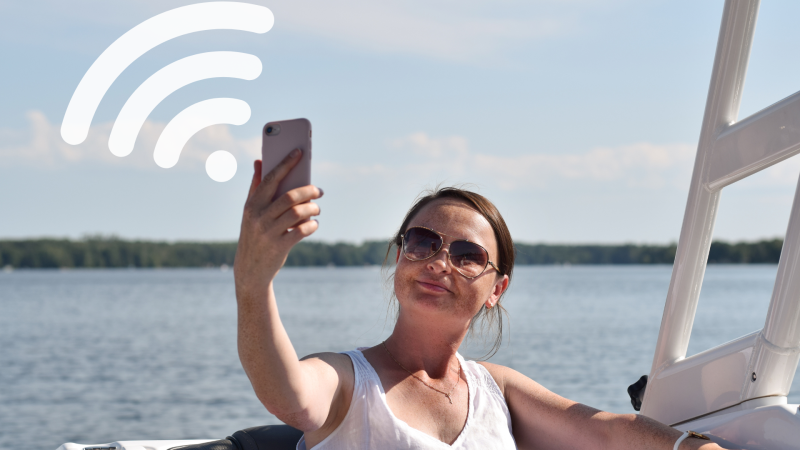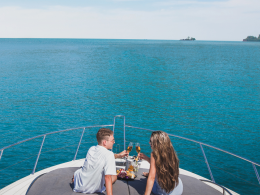Starlink has been a game-changer for many nomads traveling in RVs. However, many boaters have wanted to embrace technology. Elon Musk and Starlink promised users they’d eventually enjoy the service while floating in the ocean. We’re seeing more reports from boaters putting the service to the test. So can you binge-watch shows and video chat while traveling in a boat?
Today, we’re setting sail to put Starlink to the test. Does it work on boats as well as Musk promised?
Let’s look and see!
What Is Starlink?
Starlink is a satellite-based internet broadband service Elon Musk and his company SpaceX announced in 2015. Musk started launching low-Earth-orbiting (LEO) satellites into space, promising to deliver high-speed internet to rural locations. However, it wasn’t until 2017 that network tests on earth were possible.
Over the next several years, numerous launches have put thousands of LEO satellites into space. Over 3,000 satellites in space provide near-global coverage for the internet provider. The company supports more than a million subscribers in rural communities. However, many customers use the service for traveling in RVs and boats.
Users who wouldn’t have internet otherwise now have access to high-speed internet. Speeds can vary depending on coverage, but it’s typically enough for streaming, video chatting, and even online gaming.
HOT TIP
Get the inside scoop on The Only Way to Get Good Satellite Internet in an RV.

How Does It Work?
Starlink customers must purchase their equipment, which typically costs around $600, and roughly $110 to $135 per month for the service. This is a premium price for users with other options, but those with no choice are happy to pay for the results.
Once the customer receives their equipment, they install the dish. For those on boats or RVs, this may mean finding a temporary place to mount the dish. Once they install it, the user follows prompts in the app to connect to the dish and continue the setup process.
The Starlink dish then makes the necessary adjustments to get the optimal position. The dish connects to the thousands of LEO satellites in space to send the data to and from the router emitting the WiFi signal. The LEO satellites receive the internet from ground stations worldwide.
Since the satellites orbit the earth, the dish moves from one cluster of satellites to the next, ideally without interrupting the signal. However, the dish requires a clear view of the sky for optimal and uninterrupted service.

Would Starlink Work on a Boat?
People have used Starlink in incredible places worldwide, including wars and rescue efforts. So it is no surprise that Starlink can provide fantastic results on a boat. One of the largest cruise companies, Royal Caribbean, is investing in adding Starlink Maritime to all its cruise ships.
The service provides global maritime coverage in countries like Australia, New Zealand, Chile, Italy, Germany, Poland, Switzerland, Austria, Belgium, the United Kingdom, and the United States. The equipment can withstand cold, heat, hail, sleet, heavy rain, and even gale-force winds. However, extreme weather may interrupt your service.
How Much Does Starlink Maritime Cost?
If you thought the standard Starlink fees were expensive, wait until you hear about Starlink Maritime. The equipment cost for two high-performance terminals is $5,000. Additionally, there is a $5,000 monthly service fee for speeds up to 350 Mbps.
This isn’t something most people will install on just any boat. However, these fees are a drop in the bucket for a massive company like Royal Caribbean. They recoup their costs by offering guests internet plans for approximately $20 per device per day. Considering some of their ships can accommodate 5,000+ guests, they’ll likely have no trouble recouping their investment.
HOT TIP
Don’t know if Starlink is right for you? We uncovered 5 Reasons to Avoid Starlink Internet.

What Are the Vessels That Use Starlink Maritime?
Starlink Maritime is gaining popularity, especially as the service continues to prove itself. Potential customers see the benefits and how it can help them and their customers stay connected while on the water. Let’s examine some of the types of vessels using the service.
Cruise Ships
While Royal Caribbean was the first to launch Starlink internet on their ships, they’re no longer the only one. Carnival Corporation announced in mid-January 2023 that they started testing the service on their ships in December 2022 on Carnival Cruise Line and AIDA Cruises ships. They also mentioned adding it to Princess Cruises, Holland America Line, Seabourn, P&O Cruises in Australia, Costa Cruises, P&O Cruises in the UK, and Cunard.
Yachts
As people travel in their RVs and conversion vans, nomads travel the open waters in yachts. These individuals enjoy staying connected while out on the open waters. Many utilize the Starlink RV package instead of the maritime one, which aims at commercial use.
Is Starlink Maritime Worth It?
Starlink Maritime may not be worth it for the average boater. However, Starlink’s RV may suffice for those individuals. Starlink Maritime brings high-speed internet to large ships and yachts that would otherwise rely on slow and clunky service. While we love seeing the technology grow, we hope cruisers can still unplug and relax while on vacation.
Would you pay for the internet on a cruise ship?
If You Want the Latest Travel News, Join Our Mailing List
Don’t rely on biased RV industry news sources to keep you informed. Stick with Nomadic News. We publish articles and breaking stories that matter to you every weekday.










